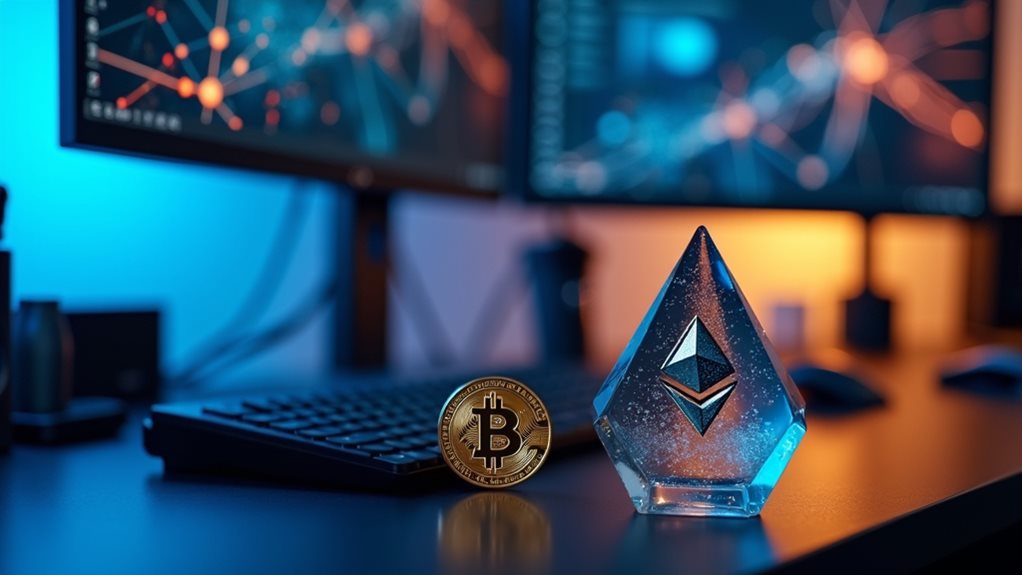Cryptocurrency investing isn’t rocket science, but it’s not a walk in the park either. Start by choosing a reputable exchange like Coinbase or Binance, verify your identity, and enable 2FA immediately. Diversify your portfolio between Bitcoin, Ethereum, and some carefully researched altcoins. Always secure your assets in appropriate wallets—hot for convenience, cold for security. Market volatility can be brutal, so only invest what you can afford to lose. The crypto rabbit hole goes much deeper than you’d expect.
Understanding the Crypto Landscape: Bitcoin, Ethereum, and Beyond

While traditional markets stumble along, crypto has been redefining what investment means in the digital age.
Bitcoin’s advantages are obvious—it’s literally digital gold, folks. At $109,900 with a $2.1 trillion market cap, it’s more than just internet money anymore. Clearer digital asset regulations have pushed institutions to jump in headfirst. Transaction processing times are notably slower at 10 minutes per block.
Bitcoin isn’t just another tech fad—it’s the ultimate digital asset, attracting institutional money like never before.
Meanwhile, Ethereum’s applications go beyond mere currency. Smart contracts. DeFi. NFTs. With $17.2 billion in daily transactions, it’s the Swiss Army knife of blockchain. Ethereum’s shift to Proof of Stake in 2022 dramatically improved its energy efficiency compared to Bitcoin. Institutional investors recognize this value, allocating 3.9% of portfolios to Ethereum on average in 2025.
Sure, it’s volatile (4.6% compared to Bitcoin’s 2.1%), but that’s the price of innovation.
Crypto market trends don’t lie. Together, these two giants command over 50% of the entire crypto market.
The kids get it—55% of young Americans will own Bitcoin by 2025.
Getting Started: Setting Up Accounts and Making Your First Purchase

Three critical steps stand between you and your crypto expedition.
First, choose the right exchange. Cryptomus, Coinbase, and Binance offer beginner-friendly interfaces with robust security features. Don’t be cheap here—prioritize safety over fees. Security measures like cold wallet storage provide essential protection for your digital assets. The goal is to buy low, sell high when trading cryptocurrencies on these platforms. Coinbase stores 98% in cold storage, making it a particularly secure choice for newcomers.
Next, the verification process. It’s a pain, sure. Submit your ID, sometimes proof of address, and wait. Could take minutes, might take days. But it’s necessary. Set up 2FA immediately after. No exceptions.
Finally, fund your account. Link your bank or card, deposit fiat currency, and you’re ready to buy. Transaction fees vary wildly—from 0% to 4% on Coinbase. Ouch.
Purchase options matter. Market orders execute now. Limit orders wait for your price. Either way, congratulations. You’re officially in the game.
Securing Your Digital Assets: Wallet Types and Best Practices

Now that you’ve bought your first crypto, you’re facing the most vital challenge: keeping it safe. Wallet security isn’t optional—it’s survival.
Hot wallets connect to the internet. Convenient? Yes. Vulnerable? Absolutely. Two-factor authentication adds an essential layer of defense against unauthorized access.
Cold storage keeps your keys offline—hardware wallets like Ledger or Trezor are the gold standard here. They’re physical devices. Unhackable remotely. Worth every penny. These devices allow you to authenticate transactions and execute smart contracts while keeping your private keys secure.
Custodial wallets let exchanges hold your keys. Easy but risky. Remember FTX?
Non-custodial wallets give you complete control. Your keys, your coins. Your responsibility too.
Mobile wallets offer convenience with risks. Desktop options provide better security.
Paper wallets? Totally offline but can burn, fade, or get soggy.
Wallet backups are non-negotiable. Lose your key management details and—poof!—your crypto vanishes forever.
No customer service hotline for that disaster.
Many users maintain multiple wallet types for different purposes, using hot wallets for transactions and cold wallets for long-term storage.
Building a Resilient Crypto Portfolio: Strategy and Risk Management

Creating a resilient crypto portfolio isn’t rocket science, but it’s close. You need portfolio diversification strategies that actually work—not just throwing darts at random tokens.
Mix large-caps like Bitcoin with smaller projects. Spread investments across different blockchain ecosystems. Gaming tokens, DeFi projects, storage solutions—get them all.
Don’t be that person with fifteen Ethereum-based tokens and nothing else.
Risk mitigation techniques aren’t optional. They’re survival tools. Use crypto ETFs for instant diversification without the homework. Try dollar-cost averaging—buy regularly regardless of price. Brutal but effective.
Consider investing in tokenized real estate for additional portfolio stability and exposure to traditional asset classes.
Rebalance regularly. Your portfolio shouldn’t look like a toddler’s dinner plate with one food taking over. Protect your assets with hardware wallets to ensure maximum security against hacks and theft.
And for heaven’s sake, diversify beyond crypto itself. Markets tank. They always do.
Include stablecoins like USDT in your portfolio to preserve capital during market downturns.
Performing Due Diligence: Research Methods for Evaluating Crypto Projects

Before you throw your money at a flashy crypto project with a cartoon monkey logo, you’d better know how to separate legitimate innovation from elaborate scams. Serious due diligence isn’t optional—it’s your financial lifeline in the crypto wilderness.
- Technical evaluation: Examine the blockchain type, consensus mechanism, and code repository. Public repositories with active developers? Good. Three commits in two years? Run.
- Financial analysis: Study the tokenomics, liquidity levels, and distribution patterns. Uneven token allocation screams “future rug pull.” With dedicated task forces now monitoring crypto markets, thorough financial analysis is more critical than ever.
- Team credibility: Background check founders and verify partnerships. Anonymous team behind a billion-dollar project? Yeah, that’s totally not suspicious.
Don’t skip regulatory compliance checks or risk assessment procedures. Market surveillance tools can help spot manipulation. The increase in institutional investment has raised standards for proper governance controls in digital assets. Use blockchain explorers like Blockchain.com to verify transaction visibility and ensure accountability.
Remember: in crypto, what you don’t know absolutely will hurt you.
Frequently Asked Questions
How Do Cryptocurrency Prices Form and What Influences Volatility?
Cryptocurrency prices form through supply-demand interactions and real-time exchange trading. You’ll notice volatility is driven by market sentiment, limited supply, liquidity fluctuations, speculative trading, and news events affecting investor confidence.
Can I Mine Cryptocurrency Instead of Purchasing It?
Yes, you can mine crypto, but consider mining profitability against considerable hardware requirements. You’ll need specialized equipment, technical knowledge, and enough capital to cover high electricity costs and initial $5,000-15,000 investment.
How Do Crypto Airdrops Work and Are They Worth Pursuing?
Airdrops distribute free tokens based on airdrop eligibility criteria like holding specific cryptocurrencies or completing tasks. They’re worth pursuing if legitimate, but verify projects carefully to avoid scams and consider potential tax implications.
What Happens to Cryptocurrencies During Global Financial Crises?
During global financial crises, you’ll notice crypto has shown mixed crisis impact. While experiencing short-term volatility, many cryptocurrencies demonstrate surprising market resilience, recovering faster than traditional markets, especially those with real-world utility.
How Does Staking Work and What Returns Can Beginners Expect?
You lock your crypto to support blockchain networks, earning staking rewards between 4-20% annually. Be aware of staking risks like illiquidity during lock periods and potential slashing penalties for validator errors.






